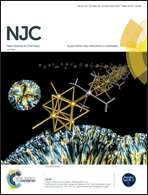Complex interaction of caffeic acid with bovine serum albumin: calorimetric, spectroscopic and molecular docking evidence†
Abstract
Herein, the interaction between caffeic acid (CA), a hydroxycinnamic acid with favorable health impacts through the prevention of degenerative pathologies, and bovine serum albumin (BSA) was investigated. The effect of CA on the conformation and thermal stability of BSA was studied using isothermal titration calorimetry (ITC), differential scanning calorimetry (DSC), circular dichroism (CD) spectroscopy, and molecular docking. Thermodynamic parameters (ΔH, ΔS, and ΔG), number of site types (N), and binding constant (K) were determined by ITC. Competitive binding of ITC with warfarin (WAR) and Ibuprofen (IBP) suggested that one of the BSA binding sites for CA was missed in the fluorescence measurements. Molecular docking studies indicate that CA binds to BSA at two sites located in the IIIA and IIA subdomains of the protein native structure. This confirmed the ITC results of competitive binding. Comprehensive DSC and CD experiments revealed a protein stability enhancement in the presence of CA. At higher concentrations, CA induces a slight decrease in the α-helix content of BSA, as observed in the far-UV CD spectra, whereby a partial unfolding of the protein occurs, as proven via both the DSC and CD experiments. This extensive study provides substantial data regarding the ligand binding effect on the protein structure that is significant for understanding the biological activity of BSA in vivo.



 Please wait while we load your content...
Please wait while we load your content...